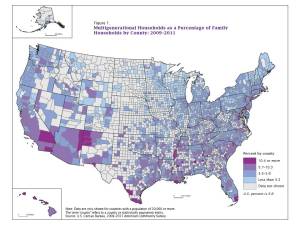5 Ways Multigenerational Households Impact Market Research
As market researchers, we in the Research Bunker are always interested in changes in the way people live. Those changes will invariably have an impact on their behavior as consumers and on our approaches to researching them. One trend that has been evident for about a decade and appears to be picking up steam is the rise of multigenerational households.
The U.S. Census Bureau has defined multigenerational households as family households consisting of three or more generations. In a Community Survey Brief published in 2012, the Census Bureau outlined three main types of multigenerational households as follows:
- Includes a householder, a parent or parent-in-law of the householder, and a child of the householder.
- Includes a householder, a child of the householder, and a grandchild of the householder.
- Includes a householder, a parent or parent-in-law of the householder, a child of the householder, and a grandchild of the householder.
According to the 2010 Census, 4% of U.S. households were multigenerational, up from 3.7% in 2000. About 5.6% of family households are multigenerational according to the Census Bureau’s 2009-2011 American Community survey. This 2010 piece from Pew Social & Demographic Trends provides some historical perspective on the trend and shows that the U.S. population living in multigenerational households has almost doubled since 1970.
The causes for this trend are varied. The recession of 2008 and subsequent sluggish job market since have certainly contributed as young adults take longer to leave the nest or return home as “boomerang kids” after being out on their own for a while and experiencing economic challenges. The aging of the population and associated health and independence concerns of seniors have led to an increase of older Americans living with their adult children. Furthermore, multigenerational households are a more traditional and common arrangement among some fast growing cultural segments such as Hispanics and Asian Americans. Regardless of the contributing factors, multigenerational households have become much more socially accepted as a viable arrangement in recent years with less of a stigma among young people than used to be the case.
This trend has a wide variety implications for marketers across the spectrum. The impact will likely be profound in sectors like consumer goods, housing and long-term care, just to name a few. Some marketers and marketing consultants have begun to take notice and reassess their strategies accordingly. For example, a UK-based research firm called Mintel recently released the results of a study that found multi-generational families are more likely than all parents surveyed to say they have increased spending on their kids. Furthermore, members of multigenerational families feel that they are underrepresented in TV and print ads.
Of course, any trend that affects marketing to that degree will necessarily have an impact on market research. Here are 5 ways that the Research Bunker believes the increase in multigenerational households has or will influence market research in the near future:
- Some of the traditional assumptions about household demographics and psychographic segmentation may change. Much traditional segmentation analysis uses households as a base unit of definition. That will likely remain the case, but as the numbers of people grow and variety of perspectives under one roof increases, the predictability of household units may diminish. Bill Schneider from Experian Marketing services (a leading provider of demographic and psychographic data) does a good job of discussing some of those shifts in this piece.
- Related to the previous point, the way that household demographic data is collected and the assumptions about some longstanding demographic survey questions may need to change. As SSI KnowledgeWatch has pointed out here, when a member of a multigenerational household is asked about the household income, do they report everybody’s income including the incomes of all working age children as well as Social Security income that the grandparents may be receiving? There’s a good chance they don’t. That’s just one example of how researchers may need to refresh their approach to what used to be standard demographic measures.
- Multigenerational households have a lot of implications for survey sampling. A lot of sampling has traditionally been based on the characteristics of the head of household/householder. As multigenerational households become more common, more information about other members of the household will need to be considered by researchers and made available by sample suppliers.
- Many quantitative and qualitative studies seek input from the “decision maker” in a household. One of the hallmarks of multigenerational households is a dispersion or specialization in decision-making roles beyond what is typically the case in a traditional household. Researchers will need to account for more nuanced or complex definitions of what defines a person as a “decision maker” when recruiting participants.
The last point is the most obvious: As the Mintel study suggests, marketers appear to be a little behind the curve on recognizing the potential of multigenerational households a fully capitalizing on them. That means that ample opportunities exist for research exploring the consumption patterns, dynamics, and preferences of this currently under-served segment.
Research & Marketing Strategies, Inc. (RMS) is a market research firm in Syracuse NY. If you are interested in using our market research consultation services please contact our Business Development Director Sandy Baker at SandyB@RMSresults.com.

Reblogged this on The Marketing Smart Aleck and commented:
Do you know somebody who lives under the same roof with their adult children? Or their elderly parents? Or their grandchildren? Or maybe all of the above? Chances are good that you do, since it’s a part of growing trend of multigenerational households in the U.S.
This is a post I wrote for The Research Bunker Blog about multigenerational households and their impact on market research. The snark content is lower than what you’ll usually find here, but the post is still loaded with creamy marketing goodness.